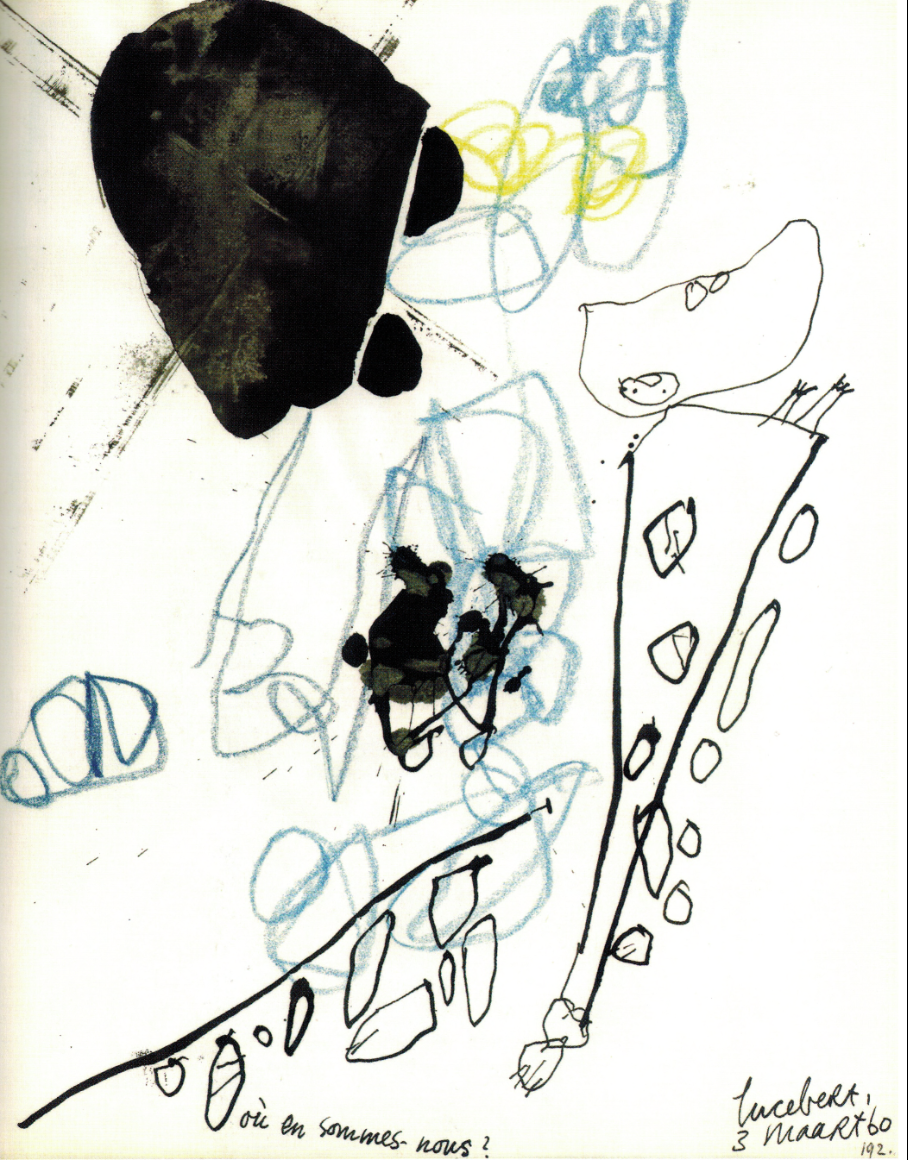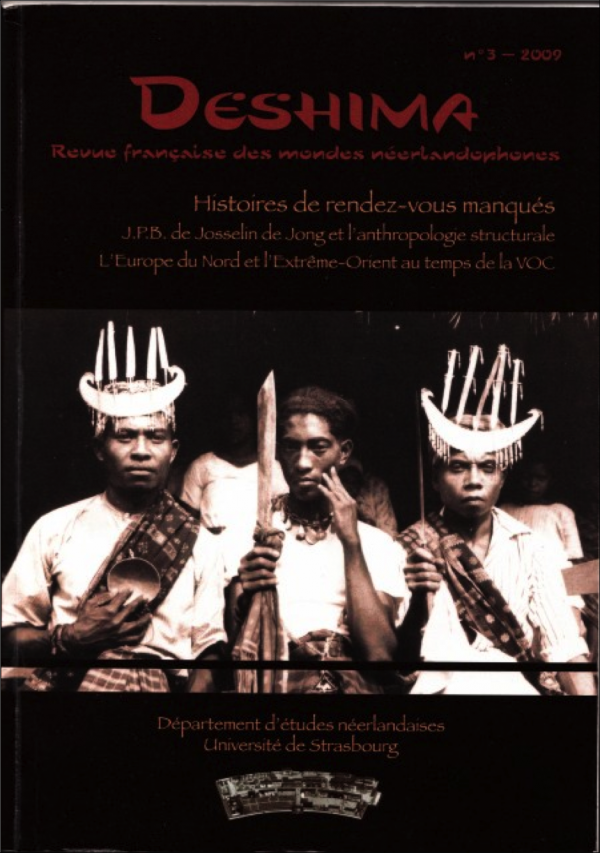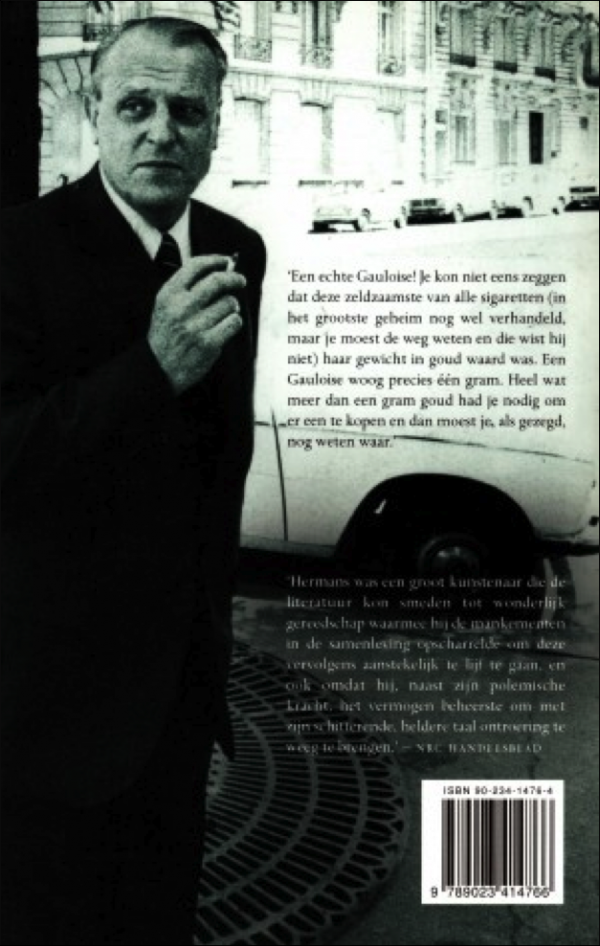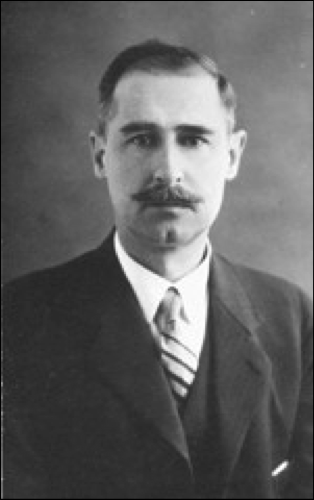Deshima, n° 3
RENDEZ-VOUS MANQUÉS ?
Histoires de rendez-vous manqués, le numéro 3 de la revue thématique annuelle Deshima vient de paraître. Il présente, en près de 500 pages, un épais dossier sur l’anthropologue et linguiste J.P.B. Josselin de Jong, un autre (en grande partie en langue anglaise) sur l’Extrême-Orient vu par des scientifiques allemands et scandinaves à l’époque de la VOC (dont un article sur l’île de Deshima !), quelques articles sur Calvin et le calvinisme, deux nouvelles et des poèmes d’auteurs néerlandais en traduction française, un essai sur le romancier W.F. Hermans et, pour finir, une escapade sous les rafales bataves.
Table des matières
Avant-propos Thomas Beaufils (p. 5)
Dossier : J.P.B. de Josselin de Jong
Biographie de J.P. B. de Josselin de long (p. 11)
Discours de Claude Lévi-Strauss (prononcé lors de la remise du prix Erasme 1973) (p. 13)
Thomas Beaufils, « Tache aveugle ». L’absence d’un contrepoint visuel a-t-elle été fatale au « structuralisme » hollandais ? (p. 21)
Nicoletta Diasio,Au grand air. L’écriture photographique de Claude Lévi-Strauss, contrepoint visuel du structuralisme (p. 47)
Kirsten Beukenkamp, Entre décolonisation et démocratisation de l’université : Quelle place pour une anthropologie des mondes contemporains aux Pays-Bas ? (p. 67)
Jean-Baptiste Beaufils, Rêve et culture chez J. P. B. De Josselin de long (p. 81)
Choix d'articles de J. P. B. de Josselin de jong
Les danses des Piegans (p. 105)
Histoire de la linguistique (p. 131)
Types culturels et phases culturelles (p. 163)
L’archipel malais, un champ d’étude ethnologique (p. 189)
Manifeste (p. 209)
Un peuple en devenir (p. 213)
Les Indes de Meijer Ranneft (p. 219)
Culture et rêve (p. 239)
De l’ethnolinguistique (p. 255)
Les pays du Nord et l’Extrême-Orient
Thomas Mohnike, L’Europe du Nord et l’Extrême-Orient au temps de la VOC. Quelques remarques introductives (p. 275)
Susanne Friedrich, Gottorf et ses collections d’histoire naturelle provenant des Indes orientales. Objets et « savoir» des non-spécialistes (p. 285)
Stefan Ehrenpreis, Germans in the VOC : scribal communication, patronage and family relations (p. 303)
Martin Krieger, The Dutch Beginnings of the Danish intro-Asiatic trade (p. 311)
Wolfgang Behschnitt, The Dutch East lndia Company in a Swedish perspective. The 1667-edition of Nils Matson Kiöping’s and Olof Eriksson Willmans travel accounts (p. 321)
Peter Rietbergen, Japon and Europe ca 1800: the pivotal role of Deshima (p. 337)
Carl Jung, An Exchange of ldeas: C.P. Thunberg’s Encounter with the Scholars of Western Studies in Japon (p. 359)
Savants mélanges
Spiros Macris, Le calvinisme hollandais et la mécanique des consciences (p. 379)
Spiros Macris, Un pamphlet différé. Vondel : Op de Ionghste Hollantsche Transformatie (p. 393)
Anonyme, La prédestination. Extrait des Canons du Synode de Dordrecht (p. 399)
Guillaume Groen van Prinsterer, La Hollande et l’influence de Calvin (p. 405)
Lettres néerlandaises
Willem Frederik Hermans fumant une Gauloise
4ème du recueil de nouvelles De laatste roker
Vonne van der Meer, L’adieu à Phœbé (p. 423)
Willem ]an Otten, Chronique d’un fils qui devient père (p. 433)
Willem Jan Otten, BW-PLO (poème) (p. 450)
Gerry van der Linden, Poèmes (p. 451)
Raymond J. Benders, Solitude, ma mère (essai sur W.F. Hermans) (p. 465)
Au fil du vent du nord
Gilles Fumey, Moulins et vélos aux Pays-Bas : quand le vent est dans la roue (p. 481)
Auteurs (p. 489)
Résumés (p. 491)
Résumés (sauf textes traduits et textes anciens)
Thomas Beaufils, So many things left to do... the forgotten texts of J.P.B. de Josselin de Jong
Through a closer observation, Dutch’s anthropologists are not very interested in the works of J.P.B. de Josselin de Jong. Of course, we can read a series of articles on the famous FAS (Field of anthropological study), the concept developed by JPB in his well-known inaugural discourse: “The Malay Archipelago as a field of ethnological study”. Meanwhile, by J.P.B.’s death, in a memoriam which dated back to 1965, anthropologist Van Baal found hard to find the qualities of our researcher: “What did this man have, so that he were able to assure such influence? It’s not his life, nor his works”. To Lévi-Strauss, the Dutch have done everything to denigrate their own research’s’ results. At the French’s side, we have been participating in an embellishment process to emphasize the works of Lévi-Strauss, which naturally finish by gaining the entire merit. At the same time, the works of J.P.B. are also as prominent. But there is still so much to do to revalorise and to embellish these works and also to make it more accessible to publics. JPB’s family owns documents (photos, letters) which researchers obtain piece hy piece. Unpublished manuscripts await to be published one day. This article focuses on the necessity of giving lights on his life on the study fields. So that one day he will gain the place he merits.
J.P.B. Josselin de Jong, portrait reproduit dans la revue Deshima
Nicoletta Diasio, “In the open air”. Photography by Claude Lévi-Strauss, a visual counterpoint of the structuralism
The pictures realized by Lévi-Strauss during the expeditions in Brazil (1935-1939), reveal some implicit tensions in all the work of the author: the oscillation between scientific rigorous concern and passion for the artistic creation, the report of the rational and the sensitive as means of knowledge, the imperative of the distance and the implicitly reflexive dimension. His photographic style weaves between the fascination for the « savage », the nostalgia of the fugitive and the wish to give a body, a face and a concrete presence to the ethnographic subjects. It discloses the change of paradigm in the fieldwork during the 30s.
Kirsten Beukenkamp, Between decolonization and democratization of university: Where to place the anthropology of the contemporary world in the Netherlands?
Dutch anthropology is strongly related to the national colonial history in which it finds its origins and to empiricism in comparison to theoretical frameworks. Anthropology of the contemporary world seems, as it questions these elements, not to have found its place in the Netherlands yet. These elements are equally present at local level. By looking at the positions and work of the Utrecht University anthropologists and the preparation of my own master research, the article tries to understand the present-day definition and meaning of Dutch anthropology as well as the new possibilities a contemporary anthropology could offer.
Jean-Baptiste Beaufils, “Culture and dream” of J.P.B. de Josselin de Jong
In his 1946 conference, Culture and dream, De Josselin de Jong seeks to establish the individual / culture report from the unconscious point of view. To this end, he questions the anthropological theories, very fashionable at the time, using Freudian theory of latent and manifest contents of the dream. But he severely criticised and rejected them when they try a junction between individual and culture by using the concept of the prevalence of symbolism in the dream. Actually, unbeknownst to him, these criticisms recur the real thought of Freud: the theory of the interpretation by the symbol is really to attribute to Jung. Well, Freud separated from Jung for the most part for that point. For his part, De Josselin de Jong concluded that it was not the approach that was absurd, but the concepts used. So, it was necessary to suspend to find the solution. My researches in development of the book De la colonisation de l’esprit allowed me to notice that further to De Josselin de Jong, Lacan and Lévi-Strauss, each constructed a piece of the solution. On the one hand, a model of the dynamics of language in the performances of an individual through the transformations in his individual myth in the cure (diagram double mirror). On the other hand, in the culture, by the myth and its dynamic in the collective, universalized by the canonical formula of myths. It appears that a culture in potential is directly organized in the individual at the level of a pre-oedipe. Freud has assumed it from his clinic. This pre-historic oedipal is the dream umbilicus and the object of a denial.
Susanne Friedrich, Gottorf and his natural history collections from oriental Indies - objects and “knowiedge” of the “unlearned” authors
This article deals with the inventory of the ‘Kunstkammer’ in Gottorf and three travelogues edited by Adam Olearius in the middle of the 17th century. During the production of these books Olearius faced objects of the Gottorf collection and the cognitions of ‘unlearned’ authors with approved knowledge. On the basis of examples mostly from the Indonesian area, a specific interaction between site, practices, accounts, and objects can be observed. This results in a more complex conception of the Scandinavian contribution to European knowledge in regard to Asia.
Stefan Ehrenpreis, Germans in the VOC – scribal communication, patronage and family relations
The paper discusses the importance of scribal communication of employees of the VOC for the spread of knowledge about Asia in the German-speaking countries. Departing from the very different examples of Johannes Stahlenbecker and Willem van Imhoff, it is shown that the distance between two continents did not define the social space established by communication. On the contrary, letters permitted to integrate people in over-sea contexts into early modern societies in Europe. As the example of Imhoff shows, letters were important for the long-term stability of family relations between Europe and Asia. The letters of Stahlenbecker served to prolong constructions of patronage. Additionally, they were read publicly and became a mean for the transmission of individual experiences of Europeans in Asia and were, thus, an important source of knowledge of Asia.
Martin Krieger, The Dutch Beginnings of the Danish intra-Asiatic trade
This paper investigates the Dutch impact on the establishment of Danish trade in the Indian Ocean region. It can be shown that the Dutch VOC served as a model for the foundation of the first Danish East India Company on an institutional as well as on a personal level. Private Dutch enterprise entered into a fruitful, but also dangerous liaison with the efforts of the Danish monarchy to enhance overseas trade during the first half of the seventeenth century.
Wolfgang Behschnitt, The Dutch East India Company in a Swedish perspective. The 1667-edition of Nils Matson Kiöping’s and Olof Eriksson Wiliman’s travel accounts
The first Swedish travel accounts from the East Indies were published in 1667. Their authors, Nils Matson Kiöping and Olof Eriksson Willman, had both served in the Dutch East India Company, so their accounts can serve as proof for the important role the VOC played for the spreading of knowledge about the new colonial world in Scandinavia. This article aims to interrogate the particular manner in which their publication transported, transformed and sometimes even distorted this knowledge subject to political and economic tensions between Sweden and the Netherlands. Special attention will be given to Willman’s description of Japan and its relation to François Caron’s widely spread account.
Peter Rietbergen, Japan and Europe ca 1800. The pivotal role of Deshima
Due to economic-political reasons, around the turn of the 18th century, Deshima was almost unreachable for Europeans. This negatively impacted the cultural transfer that had been going on since the 1630s. This essay describes the various groups who constituted the complex chain through which various kinds of textual / material culture were mediated between Japan and the West. It analyses their interests in the process. The article stresses that, during the two centuries of Deshima’s unique role, in Europe at least knowledge about Japan was not cumulative but, rather repetitive, also because each generation needed to create its own image of Japan. The important contribution - but unfortunately little impact - of the work of Isaac Titsingh, in this very period, is dealt with in detail. Last, but not least, attention is given to Japan’s (changing) interest(s) in things European, between scholarly / scientific curiosity and exoticism – Japan’s ‘occidentalist’ phase mirrors Europe’s ‘orientalist’ gaze. I argue that, moreover, in many ways, Japan’s authorities manipulated Europe for its own ends.
Carl Jung, An Exchange of Ideas. C.P. Thunberg’s Encounter with the Scholars of Western Studies in Japan
During his stay in Japan as an employee of the Dutch United East India Company in the years 1775 and 1776, the Swedish physician and botanist Carl Peter Thunberg (1743-1828) had the opportunity to engage in an extensive intellectual discussion with a number of Japanese scientists that were versed in the so called Western sciences. Whereas the exchange of goods with overseas regions was very common in 18th century Europe, this is a rare example of an exchange of ideas with extra-European people.
Spiros Macris, Dutch Calvinism and the mechanism of the conscience
This paper explores the conflict between secular power and the Reformed Church in the Netherlands. In the early 17th century, the young Republic needed a strong and unified Reformed Church to preserve the confederation, but it could not tolerate the Calvinists’ theocratic claim. For this reason, the Reformation’s influence was to be cultural instead of religious: even dissenters and the large Catholic community accepted it.
And still today, with only 19 % Reformed churchgoers, while Catholics can count on 29 %, and despite 42 % non-believers, Calvinist ethics are widely accepted and part of Dutch national identity.
Gilles Fumey, When the wind is in the wheel. Windmills and bicycles in the Netherlands
Without any doubt, wind constructs the Netherlands. Windmills have permitted to gain some lands over the sea. Bicycles induce extensions of the city and play an incomparable art of living in Europe. The genius spirit of the Dutch is to have, in each phase of their history, domesticated the wind by the wheels. Whether for windmills or bicycles, there is an equal attention given to space, which spread from the fascination for the wheels.
Pour commander Deshima : www.deshima.fr





